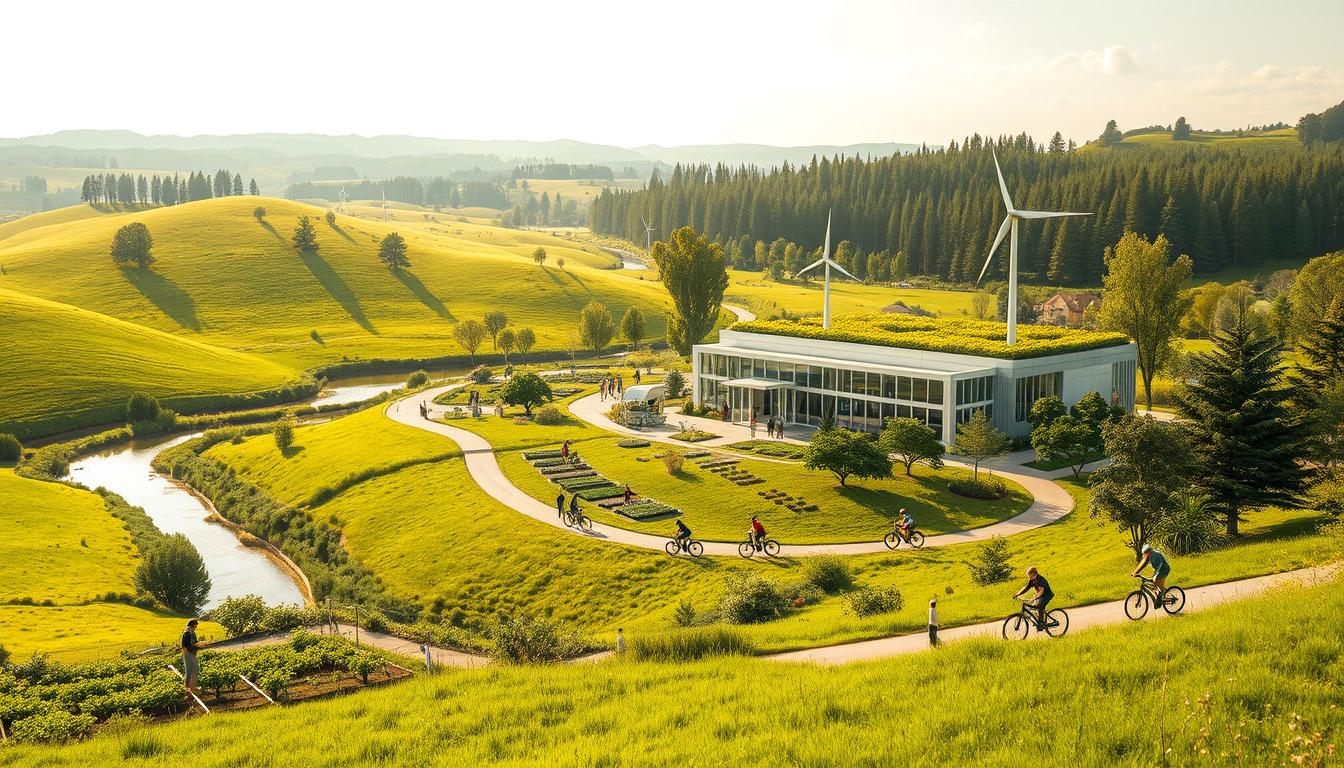Our planet is facing big challenges that need new ideas and teamwork. Rising temperatures and extreme weather are hitting communities hard. We must act quickly with smart plans.
Building resilience means more than just fixing problems as they happen. We need to plan ahead and change how we live and work. This includes new ways of designing cities and farming.
There is hope. New technologies, nature-based solutions, and policy changes offer ways forward. Communities are finding creative solutions that meet today’s needs and protect the environment for tomorrow.
This path to a better future is not just about avoiding disasters. It’s about making places healthier and more lively. By using old wisdom and new science, we can find solutions that benefit both people and the planet.
The Escalating Climate Crisis: Why Adaptation Matters Now
Our planet is at a turning point. Climate adaptation is now urgent, not just for the future. Rising sea levels, extreme temperatures, and severe weather are real. Communities worldwide need adaptation strategies to face these changes.
Current Climate Trends and Alarming Projections
Scientific data shows a dire climate path. Global temperatures have risen by 1.1°C, with the last decade being the hottest. If we don’t act, we could hit 1.5°C soon.
- The western U.S. faces severe drought, with reservoirs at historic lows
- Hurricane intensity has risen by 8% since the 1980s, causing massive flooding
- Wildfires now last nearly three months longer and burn twice as much land as 30 years ago
- Arctic sea ice is melting at 13% per decade, causing coastal erosion
The Mounting Economic and Social Costs of Inaction
The cost of climate change grows every year. In 2021, the U.S. saw 20 billion-dollar disasters, totaling $145 billion in damages. These numbers don’t include the long-term effects on agriculture, tourism, and health.
Ignoring climate change risks our infrastructure. Roads, bridges, and power grids are failing due to climate change. Investing in climate resilience now saves money compared to emergency repairs later.
Vulnerable Communities at the Frontlines
Climate change hits the most vulnerable hardest. Low-income areas lack resources for climate resilience and face extreme heat. Coastal communities face threats from rising seas and storms.
Rural areas in the Midwest and South suffer from changing growing seasons and extreme weather. The elderly, children, and those with health issues are most affected by heat waves and poor air quality.
Adapting to climate change is crucial. It’s not just good for the environment but also for the economy. The costs of not adapting are too high, affecting lives, livelihoods, and finances.
Fundamentals of Climate and Environment Adaptation
Climate and environment adaptation is about adjusting to changes while keeping nature in balance. Communities in America face more extreme weather, rising seas, and changing farms. It’s key to understand these basics for effective responses.
Adaptation strategies help us not just survive but also thrive in changing environments.
Defining Adaptation vs. Mitigation Strategies
Adaptation and mitigation are two ways to tackle climate change. Adaptation helps us deal with current or expected climate impacts. Mitigation aims to cut greenhouse gas emissions and boost carbon sinks.
Both are crucial. Mitigation stops future warming, while adaptation manages current changes. The best plans use both.
| Aspect | Adaptation Strategies | Mitigation Strategies | Combined Benefits |
|---|---|---|---|
| Timeframe | Immediate to long-term | Long-term focus | Comprehensive temporal coverage |
| Primary Goal | Reduce vulnerability | Reduce emissions | Complete climate resilience |
| Examples | Flood barriers, drought-resistant crops | Renewable energy, carbon capture | Urban forests, regenerative agriculture |
| Scale | Often local or regional | Local to global | Multi-scale integration |
Building Resilience in Natural and Human Systems
Resilience means a system can handle disturbances and stay functional. For nature, it’s about keeping ecosystems diverse to bounce back from climate shocks. For people, it’s about building strong infrastructure and societies that can face and recover from climate impacts.
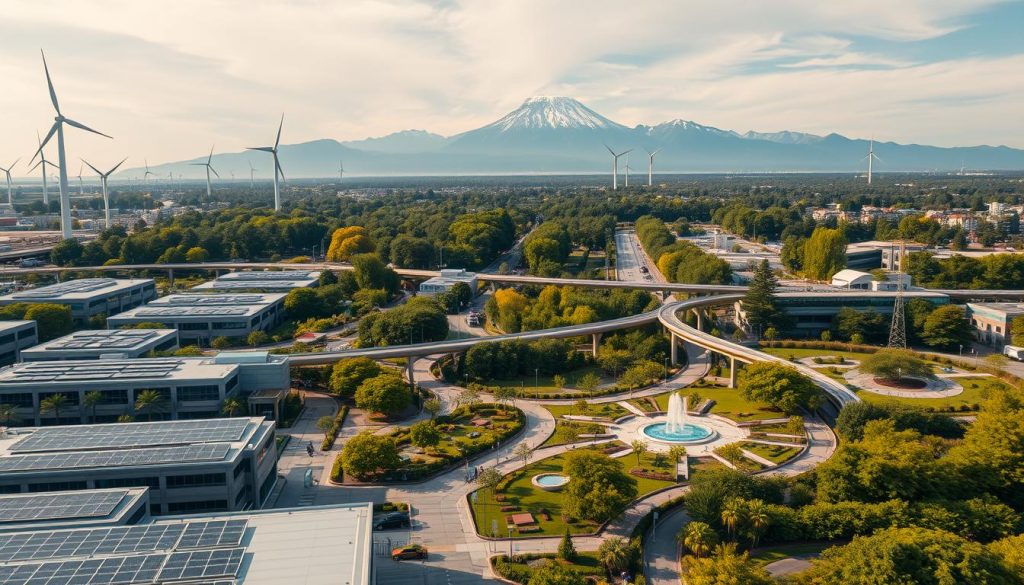
In America, good examples of adaptation are popping up. In Florida, living shorelines protect against erosion and storms. In Colorado, farmers use water-saving methods and special crops to keep farming despite changing weather.
Measuring Adaptive Capacity
Adaptive capacity is how well systems, groups, and people can adjust to climate changes. It varies a lot, based on money, tech, skills, and more.
Measuring it helps find who’s most at risk and where to focus help. Tools look at physical things like buildings and social stuff like community ties. This info helps make plans that help both adapt and mitigate.
By grasping these basics, we can make plans that are good for the environment and ready for the future. The best plans help both adapt and mitigate, making a big difference for our planet.
Key Principles of Sustainable Environmental Management
Effective climate action starts with sustainable environmental management. It works with nature, not against it. This approach helps build strong communities and ecosystems. It shows that our well-being depends on healthy nature.
We need to move from just reacting to climate issues to being proactive. We should design systems that can handle changes. The best methods mix science, technology, and community involvement.
Ecosystem-Based Approaches to Adaptation
Ecosystem-based adaptation uses nature to fight climate change. It protects and restores ecosystems. This helps with flood control, carbon capture, and temperature management.
In the U.S., coastal areas are fixing wetlands and mangroves. These act as natural barriers against storms and sea rise. Cities are also adding green spaces to fight heat and improve air.
These methods do more than just fight climate change. They also boost biodiversity, clean water, and create places for fun. This improves health and community spirit.
Circular Economy Models for Resource Conservation
The circular economy is a big change from old ways. It aims to use resources without waste or pollution. It keeps materials in use through reuse and recycling.
New waste management ideas are popping up everywhere. Companies are making products that last longer and can be easily taken apart. Cities are starting recycling and composting programs.
Key parts of the circular economy include:
- Designing products without waste or pollution
- Keeping materials in use forever
- Helping nature by returning nutrients
- Creating jobs through product-as-service models
- Building local recycling systems
Regenerative Design Thinking in Practice
Regenerative design is more than just being green. It makes systems that get better over time. It doesn’t just reduce harm; it actively makes things better.
In farming, regenerative methods improve soil and capture carbon. Buildings are designed to clean air and water and provide homes for wildlife. Transport systems are being changed to cut emissions and connect communities.
True change happens when we go beyond just reducing harm. We need to think about the whole system and how everything works together. When done right, regenerative design leads to a cycle of health for both the environment and people.
Innovative Green Technologies Driving Adaptation Solutions
As climate challenges grow, new green technologies are key to solving them. These innovations help communities face climate impacts and cut down on emissions. This shift is crucial for tackling environmental challenges.
Technology’s role in fighting climate change has grown a lot. Now, solutions are more affordable and can be used on a large scale. From capturing carbon to building smart structures, these innovations boost our resilience.
Breakthrough Carbon Capture and Utilization Methods
Carbon capture tech has moved from ideas to real-world use. Direct air capture systems pull CO2 from the air. This helps lower current carbon levels, not just new emissions.
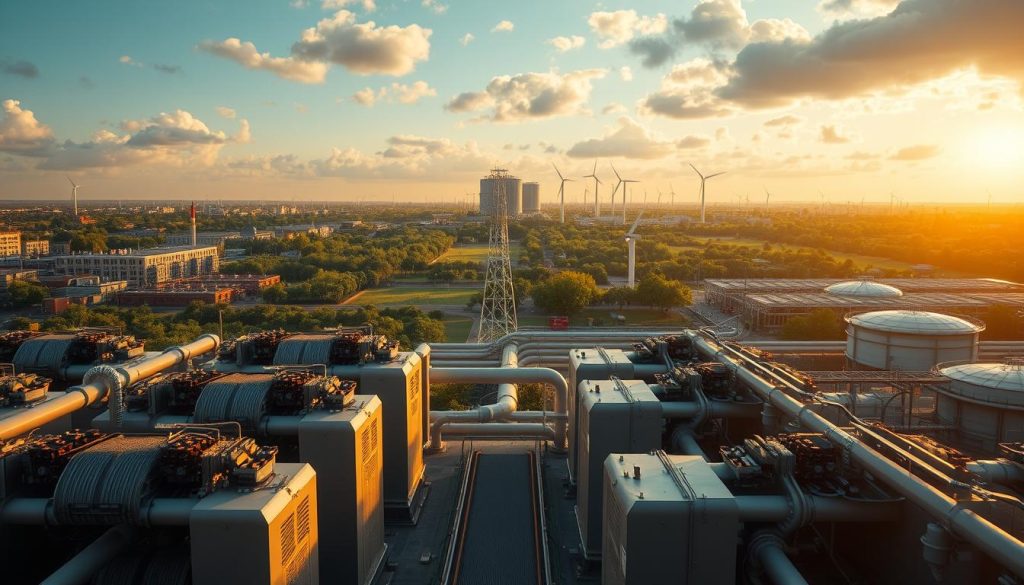
CO2 is being turned into new products like strong concrete. This not only stores carbon but also offers a strong building material. Other uses include making fuels, plastics, and even drinks, creating jobs in carbon removal.
Smart Grid Infrastructure for Climate Resilience
Old power grids struggle with climate-related issues. Smart grids offer a better way with distributed energy and advanced systems.
These networks can quickly reroute power and use renewable energy. They also balance energy needs in real-time. This means less power loss and economic damage during extreme weather.
Climate-Responsive Building Materials and Designs
The construction world is using new materials and designs for climate resilience. Phase-change materials in walls help control temperature. This reduces the need for heating and cooling.
Permeable pavements and green roofs also help. They manage rainwater and cool buildings. These innovations make buildings more resilient and help fight climate impacts.
Case Studies of Technological Innovation
In the U.S., companies are showing how these technologies work. The table below shows some examples:
| Organization | Technology | Location | Climate Impact | Results |
|---|---|---|---|---|
| Carbon Engineering | Direct Air Capture | Multiple US sites | Carbon reduction | Capturing 1M tons CO2 annually |
| Con Edison | Smart Grid Systems | New York | Storm resilience | 70% reduction in outage duration |
| Georgia Tech | Cool Roof Technology | Atlanta | Heat mitigation | 30% reduction in cooling costs |
| Portland Water Bureau | Permeable Infrastructure | Portland, OR | Flood prevention | 85% stormwater runoff reduction |
These examples prove green tech is real and works. It’s not just theory but a practical way to make communities stronger and reduce harm to the environment. As these technologies improve and costs drop, they will be used more widely, helping us adapt to climate change.
Renewable Energy Transition as a Cornerstone of Adaptation
Renewable energy technologies are key to adapting to climate changes. They help us deal with extreme weather events. By using renewable energy, we not only cut emissions but also get better at handling climate shifts.
Solar and Wind Integration Challenges and Solutions
Solar and wind power are growing in the U.S., but integrating them is tough. The sun and wind don’t always cooperate, making power reliability a big issue.
Grid operators are using advanced tools to forecast energy better. These tools use artificial intelligence to predict weather and manage energy flow in real-time.
Upgrades to the grid are also helping. They let renewable energy move where it’s needed. California and Texas are leading the way, showing others how to do it.
Energy Storage Innovations Enabling Resilience
Energy storage is changing how we use renewable power. Modern batteries let homes and businesses store solar energy for later use.
New storage solutions are emerging. These include:
- Pumped hydroelectric storage, which uses excess energy to pump water uphill
- Compressed air energy storage in underground caverns
- Thermal storage systems that capture heat for later use
- Flow batteries that offer long-term storage for the grid
Decentralized Power Systems for Community Adaptation
Decentralized energy is key for climate adaptation. Microgrids, which can work on their own, keep power flowing during disasters.
The Blue Lake Rancheria tribe in California showed how microgrids can help. They kept power on during wildfires. Community solar projects in Minnesota and Massachusetts also help by sharing renewable energy.
These systems create jobs and lower energy costs. A 2021 study showed renewable energy jobs grew fast, helping the economy and reducing carbon emissions.
Water Resource Management in an Increasingly Volatile Climate
As our climate gets more unpredictable, managing water resources is key. Communities face droughts and floods, often in the same year. We need new ways to handle water scarcity and too much water.
Drought Resilience Planning and Implementation
Drought planning has grown from just water limits to full strategies. In California’s Central Valley, farmers use rainwater to fill underground water. This helps during dry times.
Now, we can forecast droughts months ahead. This lets us save water before it’s too late. Some places charge more for water to stop waste.
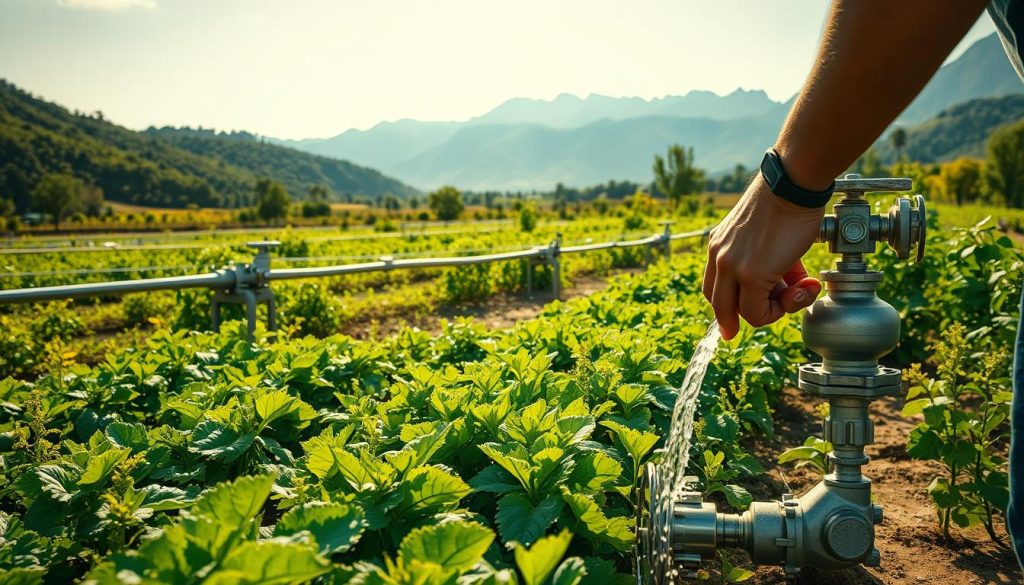
Flood Mitigation Strategies for Urban and Rural Areas
Old flood management used dams and concrete. Now, we mix these with nature to protect better. This approach works with the environment.
Urban areas use special pavement and gardens to soak up rain. This cuts down on flooding. Rural areas restore wetlands to handle rain and support wildlife.
Water Recycling and Conservation Technologies
New tech is changing how we use water. Systems clean wastewater to drinking water quality. This creates new water sources.
San Diego uses treated wastewater to reduce imported water. Smart systems find leaks fast, saving a lot of water. New irrigation methods cut down water use in farming.
Watershed Protection Approaches
Water quality and quantity depend on the land around it. Protecting watersheds is crucial for resilience. New York City’s program keeps water clean and saves money.
Watershed management brings together farmers, planners, and more. They work together to solve water problems. Healthy lands filter water and protect against extreme weather.
Transforming Agriculture for Climate Resilience
Agriculture needs a big change to fight climate change and help the environment. American farmers deal with unpredictable weather, from long droughts to big floods. These challenges offer a chance to make farming better for our planet.
Regenerative Farming Practices That Restore Ecosystems
Regenerative agriculture is more than just being green. It makes soil and ecosystems better. It works with nature, not against it.
Gabe Brown in North Dakota shows how it works. He uses cover crops, doesn’t disturb the soil much, and grazes animals carefully. His land went from poor to rich in just 20 years, keeping water and crops safe during dry times.
Healthy soil does more than help the farm. It also pulls carbon out of the air, fighting climate change. This makes farming more stable, even when the weather is bad.
Crop Diversification and Climate-Smart Agriculture
Growing the same crop over and over makes farms vulnerable. But, planting different crops helps them survive extreme weather.
The Practical Farmers of Iowa show how mixing crops and animals helps. Their farms use less fertilizer and cost less to run. They also stay profitable.
Climate-smart farming combines old wisdom with new science. It uses local crops, saves water, and controls pests naturally. This works well in changing weather.
Precision Agriculture Technologies Reducing Resource Use
Technology helps farmers adapt to climate change. Precision farming uses data to use resources better, cutting waste and boosting yields.
| Technology | Function | Resource Savings | Climate Benefit |
|---|---|---|---|
| Soil Sensors | Monitor moisture and nutrients | 15-30% water reduction | Drought resilience |
| Drone Monitoring | Early pest/disease detection | 20-40% pesticide reduction | Reduced chemical runoff |
| Variable-Rate Application | Targeted input delivery | 10-25% fertilizer reduction | Lower nitrous oxide emissions |
| Weather Modeling | Improved planting/harvest timing | Reduced crop losses | Enhanced yield stability |
Supporting Small-Scale Farmers in Adaptation
Small farmers face big climate risks with little help. In California’s Central Valley, farmers share costs for new tech. This makes tools affordable for everyone.
The USDA’s Climate Hubs help small farms with special advice. They know green practices must also be cost-effective to work.
Supporting local farms financially helps them adapt to climate change. By selling directly to consumers, they can focus on sustainability. This way, they don’t just grow for quick profits.
Biodiversity Conservation as a Climate Adaptation Strategy
As climate patterns change, saving biodiversity is key. Healthy ecosystems protect us from climate effects. They also help both animals and people. Efforts to save biodiversity are smart choices that help no matter what the future holds.
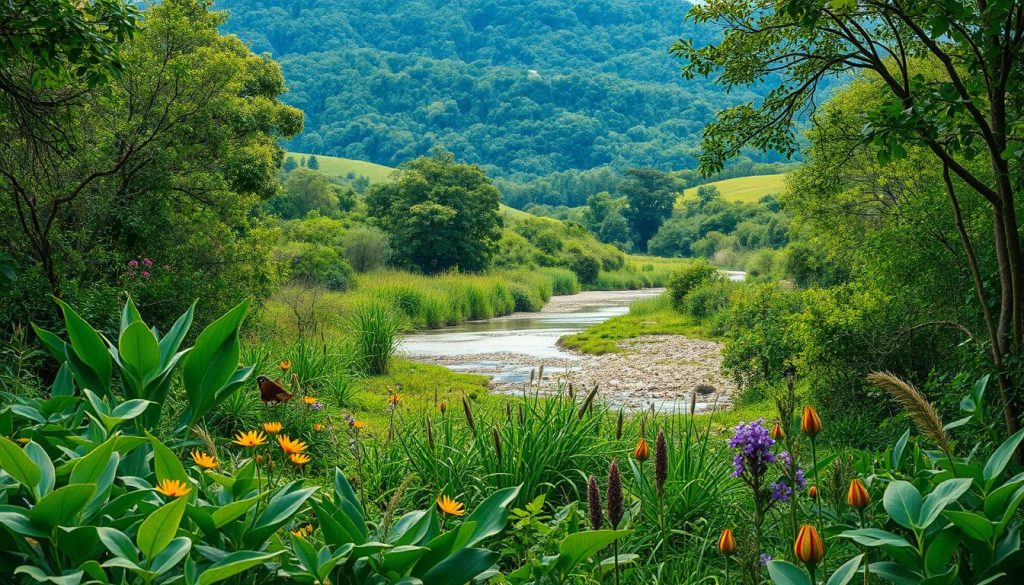
Ecosystem Services Valuation and Protection
Nature gives us vital services to fight climate change. These include controlling floods, cleaning water, storing carbon, and keeping temperatures stable. Figuring out these values has changed how we protect nature.
In the U.S., programs pay landowners to keep ecosystems healthy. For instance, New York City saved $6 billion by protecting watersheds instead of building filtration plants. This shows the value of natural systems.
- Flood mitigation through wetland preservation saves communities millions in disaster recovery
- Urban tree canopies reduce cooling costs and improve air quality
- Coastal mangroves and dunes provide natural storm barriers
- Healthy soils increase drought resilience and agricultural productivity
Wildlife Corridor Development for Species Migration
Changing climates force animals to move. Wildlife corridors help them travel and adapt. These paths keep ecosystems healthy and diverse.
The Yellowstone to Yukon Conservation Initiative spans 2,000 miles. It connects protected lands, letting species move with climate changes. Similar projects across the country show how land conservation helps wildlife and the environment.
Marine Protected Areas in a Warming Ocean
Oceans face big challenges from warming, acidification, and sea level rise. Marine Protected Areas (MPAs) protect marine life and strengthen coastlines.
California’s MPAs have seen fish populations grow. This success helps nearby fishing areas too. These areas are also key for studying ocean adaptation and supporting sustainable fishing and coastal defense.
From urban wildlife programs to big ecosystem restorations, saving biodiversity is crucial. It links environmental protection, climate adaptation, and human health. By valuing and protecting life’s complexity, we find natural allies in facing climate change.
Reimagining Urban Environments for Climate Resilience
Reimagining urban landscapes for climate resilience is a key area of focus. Cities, home to over 80% of Americans, must adapt to face climate challenges. They can implement solutions that tackle flooding, heat, and more, improving life for all.
Green Infrastructure Implementation in Cities
Green infrastructure combines nature with urban design. It’s different from traditional “gray” infrastructure, which only uses engineering. This approach uses nature to build resilience.
Cities like Portland, Oregon, use bioswales and rain gardens to manage stormwater. This reduces flood risks and filters pollutants. Philadelphia’s Green City, Clean Waters program has installed over 1,100 green features, saving billions.
Chicago’s green roofs cover over 5.5 million square feet. They absorb rainfall, reduce energy use, and fight the urban heat island effect. This shows how one solution can have many benefits.
Heat Island Mitigation Through Urban Design
Urban heat islands can make cities up to 7°F warmer. Cities are using design to cool themselves naturally.
Los Angeles is using reflective materials on streets to cool them by up to 15°F. The city aims to cover 250 lane miles by 2028. New York City has planted over one million trees, improving air quality and providing shade.
Boston’s Rose Kennedy Greenway has fountains and water gardens. They cool the area and are beautiful, inviting people to interact with them.
Climate-Smart Transportation and Mobility Systems
Transportation systems need to reduce emissions and work during extreme weather. Climate-smart approaches focus on redundancy, flexibility, and low-carbon options.
Seattle has built elevated light rail for flooding events. Minneapolis has extensive protected bike lanes for all seasons. Denver focuses on housing near public transport, reducing car use.
Electric vehicle charging is growing, with Sacramento requiring EV charging in new developments. This reduces emissions and can power homes during emergencies.
Community-Led Urban Adaptation Initiatives
Community-led efforts are bringing new ideas to urban adaptation. Detroit’s urban farming turns vacant lots into gardens, improving food security and managing stormwater.
In New Orleans, the Gentilly Resilience District combines local input with engineering. This approach creates water management systems that meet local needs and build community connections.
| Green Infrastructure Type | Climate Benefits | Implementation Challenges | Notable US Examples |
|---|---|---|---|
| Bioswales & Rain Gardens | Flood reduction, water filtration, habitat creation | Maintenance requirements, space constraints | Portland’s Green Streets, Seattle’s RainWise |
| Green Roofs | Heat reduction, energy savings, stormwater management | Higher upfront costs, structural requirements | Chicago City Hall, Brooklyn’s Barclays Center |
| Urban Forests | Carbon sequestration, cooling, air quality improvement | Long growth periods, water needs during establishment | NYC Million Trees, Atlanta’s Tree Protection Ordinance |
| Permeable Pavements | Reduced runoff, groundwater recharge, heat reduction | Higher maintenance, limited load-bearing capacity | Philadelphia’s Green Streets, Nashville’s Public Square |
Policy Frameworks Enabling Effective Climate and Environment Adaptation
Policy frameworks shape climate adaptation efforts. They range from global agreements to local initiatives. These frameworks provide structure, funding, and coordination for action.
Without strong policies, even the best ideas may not work. They help make sure actions are taken and goals are met.
Good policies create accountability and clear paths for action. They help focus resources and align efforts. They ensure adaptation measures address both immediate and long-term needs.
International Climate Agreements and Financing
Global cooperation is key to climate adaptation worldwide. The Paris Climate Agreement is a major step. It sets goals to limit warming and support adaptation efforts.
International funds like the Green Climate Fund and Adaptation Fund are crucial. They help countries with severe climate impacts. These funds are vital for developing nations facing big climate risks.
Multilateral development banks are now focusing on climate-resilient investments. They include climate considerations in their projects. This helps make climate resilience a part of global development.
National Adaptation Plans and Implementation
Countries, including the United States, are creating detailed adaptation plans. These plans identify vulnerabilities and set priorities. They also allocate resources to build resilience.
Federal programs like FEMA’s BRIC offer grants for projects before disasters. Regulatory updates also help make climate considerations part of development decisions.
National policies now value nature-based solutions alongside traditional approaches. This balanced strategy improves environmental sustainability and offers cost-effective adaptation benefits.
Local Government Initiatives Leading the Way
Cities and counties are leading in adaptation innovation. They implement solutions tailored to local risks. Municipal governments update zoning codes and building standards to face climate hazards.
Local waste management strategies are becoming more climate-resilient. Communities redesign systems to work during extreme weather. These efforts also benefit environmental sustainability and reduce vulnerability.
Community engagement at the local level is crucial. It ensures adaptation efforts meet resident needs and use local knowledge. This approach builds support and ensures investments are effective.
Public-Private Partnerships for Adaptation
Collaboration between government and private sector is speeding up adaptation. These partnerships use public resources and private innovation to develop solutions.
Insurance companies and municipalities are working together. They offer discounts for climate-resilient buildings. Utilities are upgrading infrastructure for resilience while keeping costs low.
Successful partnerships focus on equity. They ensure adaptation benefits reach vulnerable communities. This is a key shift in climate policy, recognizing the need for inclusive resilience.
Economic Opportunities in the Adaptation Economy
Climate adaptation is not just a cost. It’s a powerful economic engine with big returns. The need for climate resilience is creating new markets, jobs, and investment chances. Businesses, investors, and communities are seeing that getting ready for climate change can boost their economy and solve environmental problems.
Green Jobs Creation Through Adaptation Projects
Adaptation projects are creating jobs all over the United States. In Louisiana, coastal restoration projects have given thousands of people jobs. They help protect communities from storms.
In cities like Philadelphia and Seattle, green infrastructure projects are hiring people. These jobs range from design to maintenance, offering work for many skill levels.
Jobs in green technologies are in high demand. Workers are needed for tasks like installing permeable pavement and advanced water conservation systems. These jobs pay well because they require special skills.
The renewable energy sector is growing fast, creating more jobs than traditional energy. Solar installers and wind turbine technicians are among the fastest-growing jobs. They offer stable work in both rural and urban areas.
Climate Finance Mechanisms and Investment Trends
New financial tools are directing money to adaptation solutions at a fast pace. Green bonds, for example, raised over $290 billion globally in 2020. They fund projects like flood protection and drought-resistant farming.
Resilience funds are also emerging. They focus on projects that reduce climate risk and make money through cost savings or new revenue. These funds are a new way to fund projects in vulnerable communities.
Impact investors are seeing adaptation as a way to make money and help the environment. This shift is opening up new funding paths for resilience projects in at-risk areas.
Sustainable Business Models for a Changing Climate
Companies are finding new ways to make money by solving climate challenges. Firms making climate-resilient building materials are growing fast. Agricultural tech companies are developing crops and irrigation systems that save water, attracting farmers who want to be ahead of the curve.
Climate risk assessment services are becoming key for businesses. They help protect assets and operations from extreme weather. These services are part of a new business category created by adaptation needs.
| Adaptation Sector | Economic Opportunity | Job Types | Investment Mechanisms |
|---|---|---|---|
| Coastal Resilience | $400B market by 2030 | Engineers, construction workers, ecologists | Catastrophe bonds, resilience funds |
| Sustainable Agriculture | $135B in annual revenue | Agronomists, tech specialists, farm managers | Green loans, impact investments |
| Urban Water Management | $90B infrastructure need | Hydrologists, landscape architects, installers | Municipal green bonds, PPPs |
| Renewable Energy Sources | $500B+ global market | Installers, engineers, maintenance technicians | Tax equity, green bonds, venture capital |
Companies that start early in the adaptation economy get ahead. They help their communities become more resilient. By taking these steps, the United States can lead in this growing field, creating wealth while solving big environmental problems.
Embracing Our Responsibility: A Call for Collective Action
We all need to work together to tackle Climate and Environment Adaptation. This effort spans from our homes to big companies. Communities in America are showing great strength and creativity in facing these challenges.
Homeowners can make a big difference by adding insulation, collecting rainwater, and growing native plants. These actions cut down on carbon emissions and get our homes ready for extreme weather. Businesses can also play a role by planning for climate risks and managing waste better.
Local governments are key in leading the way. They can update building codes, invest in green projects, and prepare communities for emergencies. These steps protect people, create jobs, and boost the economy.
The biggest hurdle is our mindset. We often focus on short-term gains and stick to what’s familiar. To overcome this, we need to imagine a better future. A future with cleaner air, more green spaces, and stronger community ties.
Adapting to climate change is not just about survival. It’s about living well through these changes. By working together, we can build communities that are not only resilient but also healthier, fairer, and more lively. We have the tools and knowledge. Now, we just need the courage and wisdom to use them.

